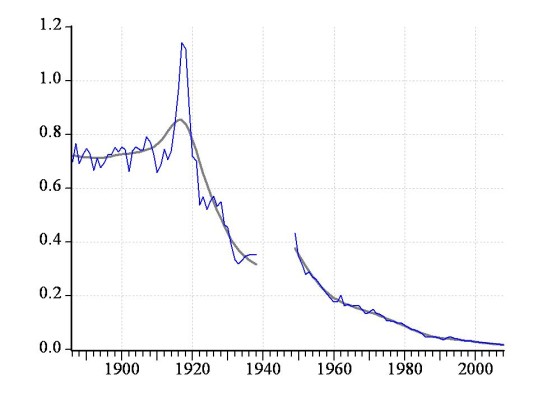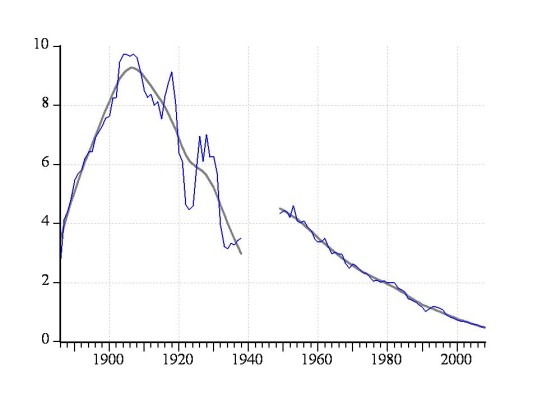Economic development and accident insurance:
On the relationship between economic circumstances and prevention
Recent literature tends to regard non-fatal occupational accidents as being influenced by political measures in the widest sense – which of course include accident prevention measures (Boone and van Ours, 2006, p. 1084-1085). If this line of argumentation is held to, the reduced volatility of non-fatal occupational accidents can be seen as a successful long-term outcome of early efforts and reform in the field of statutory accident insurance.
With consideration of the highly significant statistical assessment of long-term elasticity, it was demonstrated during the research project that real (i.e. unadjusted) expenditure on prevention by the German social accident insurance institutions since the Second World War had the following effect on the incidence and severity of accidents: The real (i.e. adjusted) total of 14.04 billion Euros spent by the German social accident insurance institutions on prevention reduced non-fatal occupational accidents by around 1.57 million cases and fatal occupational accidents by around 106,124 cases.
This examination of the relationship between economic circumstances and prevention reached three main conclusions:
- On the one hand, it was demonstrated that significantly reduced fluctuation in non-fatal occupational accidents during the period after the Second World War can be seen as a successful long-term outcome of early efforts and reform in the field of the statutory accident insurance system.
- On the other, it was shown that the incidence and severity of accidents during the post-war period exhibited a highly significant long-term statistical reaction and link to real (i.e. adjusted) expenditure on prevention.
- In addition, it was proven that prevention effort has a significant yet asymmetrical effect on occupational accidents during times of downturn – even in the short term.
This DGUV research project examined the relationship between economic development, expenditure on prevention and trends in both fatal and reportable occupational accidents in Germany.
The number of occupational accidents per thousand full-time employees recorded by the German social accident insurance institutions has fallen rapidly since the end of the first decade of the 20th century. From the end of the second decade of the 20th century onwards the same has applied to fatal occupational accidents. In addition, inflation-adjusted expenditure on prevention has risen twenty-fold since the 1950s. In view of this long-term trend, this research project examined the economic dynamics of the relationship between the aggregated cost and benefit of accident prevention. It showed that both the incidence and severity of accidents and real (i.e. adjusted) expenditure on prevention are significantly procyclical variables which mimic the economic cycle with minimal delay. Times of downturn are characterized by a distinctly negative relationship between occupational accidents and expenditure on prevention (see figures).
Contact

Dr. Thomas Kohstall
Institute for Work and Health of the German Social Accident Insurance (IAG)
Head of Department Qualification
Tel.: +49 30 13001-2300
E-Mail

